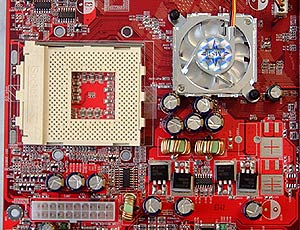 USB 2.0 is taken care of by a tiny NEC BGA chipset
by the last PCI slot. Even though USB 2.0 has had a relatively slow
and rocky start, peripherals are finally starting to pop up in the
marketplace.
USB 2.0 is taken care of by a tiny NEC BGA chipset
by the last PCI slot. Even though USB 2.0 has had a relatively slow
and rocky start, peripherals are finally starting to pop up in the
marketplace.
I would guess
that by mid-summer there will be enough USB2.0 devices to make it a required
device for any computer.
The USB2.0 riser makes mention of Bluetooth because this motherboard
as support for it, or at least indirectly. Based on what we saw at COMDEX fall
last year, I can only assume that this is for some type of
Bluetooth riser card.
Connector "JBT2"is used to connect a Bluetooth
module to the motherboard (I have yet to see one of these "modules anywhere).
The reason for the sticker over the last USB2.0 port is that the connector
shares the USB interface. This USB port will not function when the Bluetooth
module is attached to the connector.

For the
moment however, the four USB2.0 ports are more useful as backwards
compatible USB1.1 ports. Among the other list of risers that come with the KT3
Ultra a standard two port UBS1.1 with Dr. LED diagnostics, and an audio
"S-bracket" which allows users to hook up an optical SPDIF, or various
other audio cables for 5.1 channel sound. The 5.1 audio solution comes from the Realtek AC'97 codec. If MSI had
used the C-Media 8738 then the board would have been perfect in my
opinion.
There were some interesting markings on the PCB where jumpers were silk screened, but not soldered in place. The jumpers seemed to allow for 166 MHz CPU FSB... I'm not sure what to make of this since the KT333 doesn't officially support a 166 MHz FSB, but perhaps MSI plans to use this PCB design or the VIA KT400 chipset (aka KT333A) in the near future.
Processor Socket
MSI has cleared the area around the CPU
socket meaning that installation of larger heatsinks such as the Alpha PAL8045,
Swiftech MCX462 or even Thermaltake's Volcano 7 should not be a problem. Like
most Socket A motherboards the MSI KT3 Ultra-ARU has the 4 holes around the CPU
socket. However unlike a lot of other boards, the ones on the MSI boards are
grounded as you can see. Again, it's the little things that count!

VIA KT333 Chipset:

|

|
| KT333 Northbridge |
VT8233A Southbridge |
